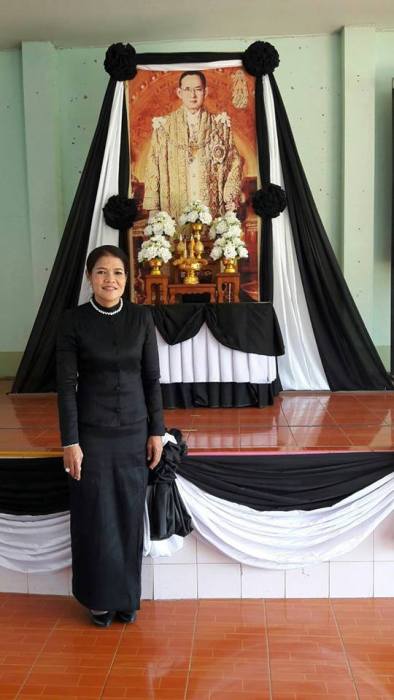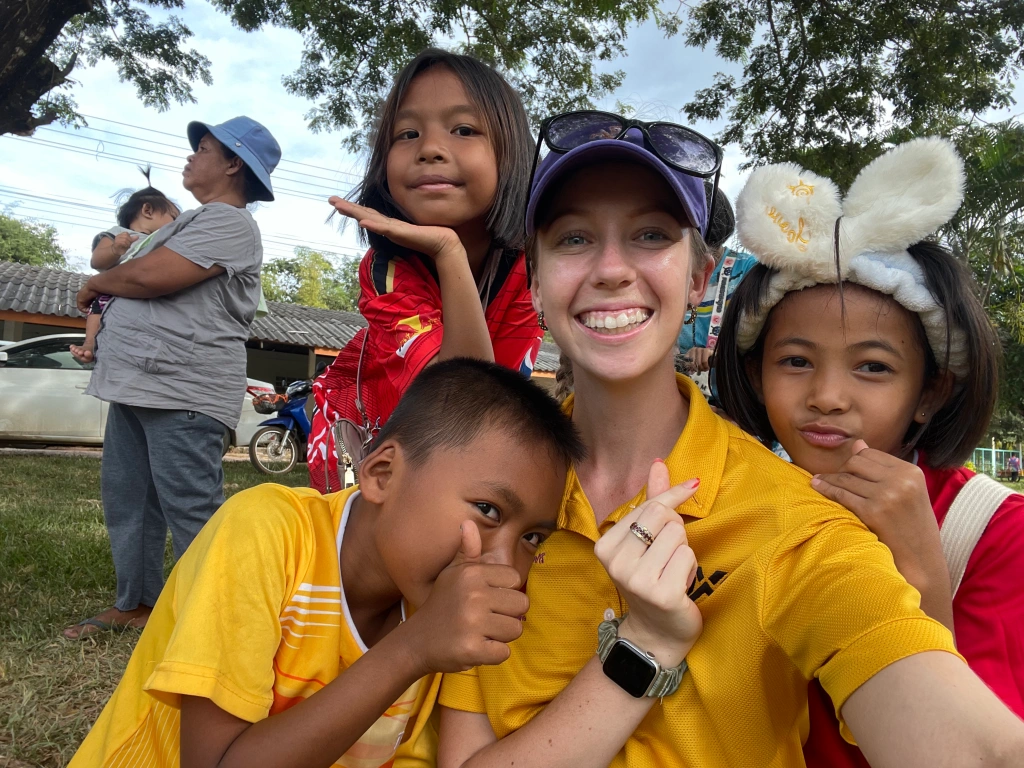William Blackford, 128 YinD
It’s Monday afternoon. Just like every Monday afternoon, I get on my bike and brave the direct sunlight for the short, five minute ride from the office, through back roads, past the sugar cane fields and the temple to my Monday school for my two hours of teaching.
My co-teacher messaged me earlier in the day to say that she wouldn’t be able to be there, but that the student teacher would help me out. This is not an unusual occurrence and going with the flow is the name of the game around here, so I give her a ไม่เป็นไร and head on my way.
The usual sounds of call-and-response teaching greet me as I pull up at the school. I park my bike and walk up the stairs to my classroom. After rounding a corner I poke my head through the door and see something which shocks me to my very core; all of the students, every single one of them, are sitting quietly at their desks studying, and there isn’t a teacher in sight. Every volunteer who has ever been to a Thai school will stare in disbelief at the statement I just wrote, but I assure you it happened.
How is this possible? This is a question I have asked myself so many times, because the story I just told wouldn’t ever happen at any of the other five schools I have taught at so far. So I thought I would start by going right to the source.
 This is Teacher Bung (ครูบุ้ง). She teaches sixth grade at Ban Rai School. She is in her late 30s and has been teaching at the school for 7 years. I have told her many times that her students are the most well-behaved I have ever encountered here in Thailand. When I ask her how she does it she says sheepishly that she is very strict with them. I don’t see much of that when I’m around, but I believe her.
This is Teacher Bung (ครูบุ้ง). She teaches sixth grade at Ban Rai School. She is in her late 30s and has been teaching at the school for 7 years. I have told her many times that her students are the most well-behaved I have ever encountered here in Thailand. When I ask her how she does it she says sheepishly that she is very strict with them. I don’t see much of that when I’m around, but I believe her.
One day when I walked in to teach my hour, she was lecturing the students about not doing their homework. My presence did not deter her from finishing the tongue-lashing she was giving to them. She later apologized to me for being so harsh with them and expressed her concern and frustration. She told me that she has high expectations for them so she pushes them hard, but in the end she just wants to see them succeed, for them to have a good life. She takes it very personally when they are disobedient or don’t measure up to her standards, and she seems pretty aware that her reaction is sometimes quite strong. In any case, it is incredibly clear to me that she cares a lot about her students, even if her way of nurturing them is different than mine.
It’s Tuesday afternoon. On Tuesdays I get to stay home in the morning and catch up on housework or studying Thai. It also means I get to sleep in. After lunch I hop on my bike and ride the 3 km to the school closest to my house. Although the ride is short, I often still change into my biking clothes because the heat can make me sweat through my polo shirt and jeans in only a few minutes if I’m not careful.
As I approach the school I can feel a knot in my stomach forming in anticipation of what will greet me when I arrive. I turn the corner to enter the long driveway and see something that defies no one’s expectations; chaos reigns in the schoolyard as kids attempt to play organized sports without organization, rove around the school in groups going who-knows-where, and run right up to me to start the day. There is no prep time, no catching my breath from the ride. It’s go-go-go from the second I step foot on school property. It looks like an unsupervised recess. Except it’s not recess. It’s 2:00 pm and the kids are supposed to be in class.

Teacher Chompooh with some of her students.
Teacher Chompooh (ครูชมพู่) is a 29 year-old with two English degrees who currently teaches first grade. She has been teaching at Ban Wangbost School since 2014. The first day I came to the school, back when I taught three grades instead of one before deciding that no human being has the energy for that at this school, I asked her “Is it always like this?” She looked around a little perplexed and said “You mean all the running around and screaming?” Turns out the answer was, “Yes, always.”
After the first few initial weeks I narrowed my focus down to just grade six in order to preserve my sanity. Something the boys in particular have a habit of doing is hitting each other. Unless they are sitting at their desks physically out of reach of one another they are wrestling, kicking, hitting, and slapping. Being out of reach doesn’t stop them from throwing things at one another, either.
One day I got frustrated and tried to talking to them about it. I asked them, “It seems like you guys are mad at each other often. Is this true? Does it feel good when someone hits you? Then why do you do it?” Most of the time the answer was a blank stare, “We’re just playing,” or “He hit me first,” but one kid actually answered that he doesn’t think, he just reacts when he’s angry. I should also say that during this entire conversation they were still hitting each other. I pointed this out to them as if it would prove something but they seemed unaffected by my attempt to logic them into obedience.
One day I was watching from a distance as the students lined up at the end of the day before going home. The grade six boys were being rowdy as usual, hitting each other and not staying seated. The teacher in charge of them responded by going over and smacking a couple of the kids on the top of the head. This disciplinary technique, as I could have guessed, had absolutely zero effect on their behavior. Most of the time they just laugh it off.
When I talked to Teacher Chompooh about it she said she sometimes thinks about hitting them but doesn’t because she เกรงใจ (she doesn’t want to make me feel bad). I thanked her for that but also asked her if she thinks using physical punishment like that actually works. Her answer told me she wasn’t sure but didn’t know what else to do. I told her that if a kid hit another kid in a U.S. school they would be sent to the principal’s office instead. The thing about that, though, is that the principal has to be someone who actually takes an active interest in their school and their students for that to work.

The Thailand equivalent of the school principal is the Paw Aw, the School Director. Paw Aw Noo (ผ.อ. หนู, กัญญาณัร โรจนวิเชียน) has been the director of Ban Rai School for about a year. Before that she was an Assistant Director at another school, and before that she was a teacher. She is also the aunt of Teacher Chompooh from Wangbost School.
She doesn’t think of herself as the School Director, but as a teacher to all the students at her school. I have often seen her teaching lessons to students when the other teachers have to go out and run errands, and she said that if the teachers have free time she asks them to go around to other classes and talk to the students. Early one morning when I rode by the school I saw her waiting outside the front gate greeting all the parents and students as they came in.
When I asked her what her philosophy on teaching the kids at Ban Rai School was she said that she follows the example of her King (Bhumibol Adulyadej). Much like her dearly departed King, she views all of the youth at her school not just as students, but as her own children. She said that it was important to take care of the school so that the kids feel grateful for the school and the opportunity to learn. She plants a garden on the property behind the school and uses the food grown there to help make lunch for the students more interesting.
She makes it a particular point to distinguish between geng (เก่ง) and dii (ดี). Geng means skilled, or talented, whereas dii mostly just means good. She told me that she doesn’t focus on making her students skilled, but that she wants them to be good people (คนดี). I thought that was a really interesting distinction to make, and one that I don’t think is typical of many Thai educators.
It’s Monday again. Today the students are very well-behaved as usual. In spite of this, the task I give them takes them a while to start. They hem and haw and won’t put pen to paper until they ask a lot of clarifying questions about what it is they’re supposed to be doing. Well-behaved also means follow the rules and don’t think outside the box. I wait for one kid to make the characteristic อ๋อ sound that means they finally understand it and can help me explain it to their friends.
It’s pretty clear, though, that they understand the lesson. It takes them a while and they struggle with out of the box thinking, but I rarely doubt that they understood my lessons as long as they involve obvious results and rules. Ban Rai is the only school where the kids don’t run out of English words to use during our Monkey in the Middle games (you have to say a word in English before you can throw the ball). It’s also the only school where the teacher stays to help me even when they don’t have to.
 Here is a photo of a student teacher, Teacher Kaow (ครูข้าว), helping the students with an activity without even being asked. I couldn’t believe it.
Here is a photo of a student teacher, Teacher Kaow (ครูข้าว), helping the students with an activity without even being asked. I couldn’t believe it.
I teach two classes, grade six for one hour, and combined grades four and five for the second. In a surprising departure from other schools, who usually want to give you as much time as possible, Ban Rai School doesn’t have any extra time for me to come teach. Even getting them to give me two hours instead of one took a lot of convincing. This means that there is less unstructured time when I can just sit around and play, chat, and get to know the kids.
After class is over I make small talk with the teachers while the kids line up for the end of the day. When it’s over the students file out of the school row by row. The teachers leave as soon as the students do, some getting on their motorcycles to help escort the kids across the busy main street nearby. I linger as long as I can but the school empties out pretty quickly and I hop on my bike to head back to the office.
Tuesday rolls around once more. I finish teaching my hour-long class for the grade six students at Ban Wangbost. It didn’t take them as long to complete the assignment I gave them as it did for the students at Ban Rai so we have time left over before they have to go home. I’m not really certain they absorbed the meat of it, but they definitely adapted to the curve balls I threw at them very quickly.
The chaos resumes as the kids reenter their largely unsupervised day. Some of the kids go outside to play sports, asking me to come along. I tell them to go ahead without me and I’ll be out later. In the meantime, I hang out in the classroom with some of my favorites.
Giao is a funny kid who loves to tease me. She is the niece of Teacher Chompooh. When I asked her during the lesson on careers what she wanted to be when she grows up she smiled and said “คนธรรมดา,” which means she just wants to be an average person. We tease each other and make faces while we take turns writing funny things on the board.
Ice asks me if I remember all the students’ names. After some effort I am able to name them all as she points to them in turn and I beam proudly as she nods her approval. Out of all the groups of kids I teach, they are the only ones that I can truthfully say that about (to be fair, I have a hard time remembering names in English).
Flook comes in from outside and asks again if I want to play football today. He says “You always say ‘next week, next week,’ but then you never play.” I can’t argue with that logic so I leave the room and head out to the field to run around a little.
These kids have real personality. I know their likes and dislikes. I know that May has attitude but is loyal to her friends. I know that Rot will pretend to not understand something I said just to tease me. I know that Pong will do anything he can to make his friends laugh, even if it disrupts my lesson. They are my most disobedient group of students, but I also have the closest relationship with them. Most of my kids call me P’ Will, but with these kids it really feels true.
Unsupervised play at Wangbost School, including kids who are not even from my class just wandering around the campus.
What I really want to show here is that neither of these schools is better than the other.
One looks better. The students behave the way we would expect them to and they are easier to teach in the classroom. I don’t have to watch them hit each other and I don’t have to use any classroom management techniques to keep them focused — they actually shush each other while I’m talking sometimes. They listen to their teachers and to each other. They see the value in education.
The other has kids that are comfortable being themselves. They have personality that is less restrained, less reigned in. They speak out, and they speak out of turn. They are not afraid to just do something. They treat me like an older brother. They treat me like family. As we all know, families are kind of a love/hate thing sometimes.
They are different but each has things about them that I love. This juxtaposition shows me that there is so much nuance here, so much to learn, even within my own little community in the relative middle of nowhere. There is so much life here in this world of ours. There is so much to experience. I feel privileged to be able to take it all in, both the good and the bad.
Here’s to going wherever the journey takes us.







Share your thoughts